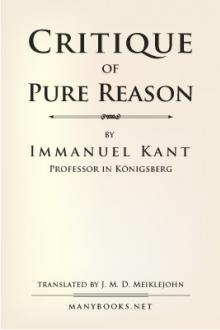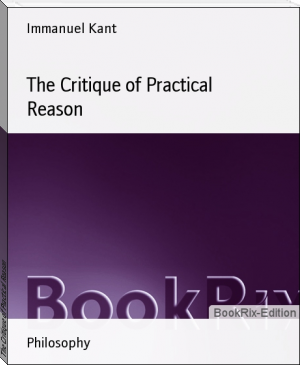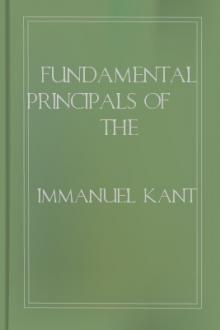The Critique of Pure Reason, Immanuel Kant [english books to improve english TXT] 📗

- Author: Immanuel Kant
- Performer: -
Book online «The Critique of Pure Reason, Immanuel Kant [english books to improve english TXT] 📗». Author Immanuel Kant
The schema is, in itself, always a mere product of the imagination. But, as the synthesis of imagination has for its aim no single intuition, but merely unity in the determination of sensibility, the schema is clearly distinguishable from the image.
Thus, if I place five points one after another …. this is an image of the number five. On the other hand, if I only think a number in general, which may be either five or a hundred, this thought is rather the representation of a method of representing in an image a sum (e.g., a thousand) in conformity with a conception, than the image itself, an image which I should find some little difficulty in reviewing, and comparing with the conception. Now this representation of a general procedure of the imagination to present its image to a conception, I call the schema of this conception.
In truth, it is not images of objects, but schemata, which lie at the foundation of our pure sensuous conceptions. No image could ever be adequate to our conception of a triangle in general. For the generalness of the conception it never could attain to, as this includes under itself all triangles, whether right-angled, acute-angled, etc., whilst the image would always be limited to a single part of this sphere. The schema of the triangle can exist nowhere else than in thought, and it indicates a rule of the synthesis of the imagination in regard to pure figures in space. Still less is an object of experience, or an image of the object, ever to the empirical conception. On the contrary, the conception always relates immediately to the schema of the imagination, as a rule for the determination of our intuition, in conformity with a certain general conception. The conception of a dog indicates a rule, according to which my imagination can delineate the figure of a four-footed animal in general, without being limited to any particular individual form which experience presents to me, or indeed to any possible image that I can represent to myself in concreto. This schematism of our understanding in regard to phenomena and their mere form, is an art, hidden in the depths of the human soul, whose true modes of action we shall only with difficulty discover and unveil. Thus much only can we say: “The image is a product of the empirical faculty of the productive imagination—the schema of sensuous conceptions (of figures in space, for example) is a product, and, as it were, a monogram of the pure imagination a priori, whereby and according to which images first become possible, which, however, can be connected with the conception only mediately by means of the schema which they indicate, and are in themselves never fully adequate to it.” On the other hand, the schema of a pure conception of the understanding is something that cannot be reduced into any image—it is nothing else than the pure synthesis expressed by the category, conformably, to a rule of unity according to conceptions. It is a transcendental product of the imagination, a product which concerns the determination of the internal sense, according to conditions of its form (time) in respect to all representations, in so far as these representations must be conjoined a priori in one conception, conformably to the unity of apperception.
Without entering upon a dry and tedious analysis of the essential requisites of transcendental schemata of the pure conceptions of the understanding, we shall rather proceed at once to give an explanation of them according to the order of the categories, and in connection therewith.
For the external sense the pure image of all quantities (quantorum) is space; the pure image of all objects of sense in general, is time. But the pure schema of quantity (quantitatis) as a conception of the understanding, is number, a representation which comprehends the successive addition of one to one (homogeneous quantities). Thus, number is nothing else than the unity of the synthesis of the manifold in a homogeneous intuition, by means of my generating time itself in my apprehension of the intuition.
Reality, in the pure conception of the understanding, is that which corresponds to a sensation in general; that, consequently, the conception of which indicates a being (in time). Negation is that the conception of which represents a not-being (in time). The opposition of these two consists therefore in the difference of one and the same time, as a time filled or a time empty. Now as time is only the form of intuition, consequently of objects as phenomena, that which in objects corresponds to sensation is the transcendental matter of all objects as things in themselves (Sachheit, reality). Now every sensation has a degree or quantity by which it can fill time, that is to say, the internal sense in respect of the representation of an object, more or less, until it vanishes into nothing (= 0 =
negatio). Thus there is a relation and connection between reality and negation, or rather a transition from the former to the latter, which makes every reality representable to us as a quantum; and the schema of a reality as the quantity of something in so far as it fills time, is exactly this continuous and uniform generation of the reality in time, as we descend in time from the sensation which has a certain degree, down to the vanishing thereof, or gradually ascend from negation to the quantity thereof.
The schema of substance is the permanence of the real in time; that is, the representation of it as a substratum of the empirical determination of time; a substratum which therefore remains, whilst all else changes. (Time passes not, but in it passes the existence of the changeable. To time, therefore, which is itself unchangeable and permanent, corresponds that which in the phenomenon is unchangeable in existence, that is, substance, and it is only by it that the succession and coexistence of phenomena can be determined in regard to time.)
The schema of cause and of the causality of a thing is the real which, when posited, is always followed by something else. It consists, therefore, in the succession of the manifold, in so far as that succession is subjected to a rule.
The schema of community (reciprocity of action and reaction), or the reciprocal causality of substances in respect of their accidents, is the coexistence of the determinations of the one with those of the other, according to a general rule.
The schema of possibility is the accordance of the synthesis of different representations with the conditions of time in general (as, for example, opposites cannot exist together at the same time in the same thing, but only after each other), and is therefore the determination of the representation of a thing at any time.
The schema of reality is existence in a determined time.
The schema of necessity is the existence of an object in all time.
It is clear, from all this, that the schema of the category of quantity contains and represents the generation (synthesis) of time itself, in the successive apprehension of an object; the schema of quality the synthesis of sensation with the representation of time, or the filling up of time; the schema of relation the relation of perceptions to each other in all time (that is, according to a rule of the determination of time): and finally, the schema of modality and its categories, time itself, as the correlative of the determination of an object—whether it does belong to time, and how. The schemata, therefore, are nothing but a priori determinations of time according to rules, and these, in regard to all possible objects, following the arrangement of the categories, relate to the series in time, the content in time, the order in time, and finally, to the complex or totality in time.
Hence it is apparent that the schematism of the understanding, by means of the transcendental synthesis of the imagination, amounts to nothing else than the unity of the manifold of intuition in the internal sense, and thus indirectly to the unity of apperception, as a function corresponding to the internal sense (a receptivity). Thus, the schemata of the pure conceptions of the understanding are the true and only conditions whereby our understanding receives an application to objects, and consequently significance. Finally, therefore, the categories are only capable of empirical use, inasmuch as they serve merely to subject phenomena to the universal rules of synthesis, by means of an a priori necessary unity (on account of the necessary union of all consciousness in one original apperception); and so to render them susceptible of a complete connection in one experience. But within this whole of possible experience lie all our cognitions, and in the universal relation to this experience consists transcendental truth, which antecedes all empirical truth, and renders the latter possible.
It is, however, evident at first sight, that although the schemata of sensibility are the sole agents in realizing the categories, they do, nevertheless, also restrict them, that is, they limit the categories by conditions which lie beyond the sphere of understanding—
namely, in sensibility. Hence the schema is properly only the phenomenon, or the sensuous conception of an object in harmony with the category. (Numerus est quantitas phaenomenon—sensatio realitas phaenomenon; constans et perdurabile rerum substantia phaenomenon—
aeternitas, necessitas, phaenomena, etc.) Now, if we remove a restrictive condition, we thereby amplify, it appears, the formerly limited conception. In this way, the categories in their pure signification, free from all conditions of sensibility, ought to be valid of things as they are, and not, as the schemata represent them, merely as they appear; and consequently the categories must have a significance far more extended, and wholly independent of all schemata. In truth, there does always remain to the pure conceptions of the understanding, after abstracting every sensuous condition, a value and significance, which is, however, merely logical. But in this case, no object is given them, and therefore they have no meaning sufficient to afford us a conception of an object. The notion of substance, for example, if we leave out the sensuous determination of permanence, would mean nothing more than a something which can be cogitated as subject, without the possibility of becoming a predicate to anything else. Of this representation I can make nothing, inasmuch as it does not indicate to me what determinations the thing possesses which must thus be valid as premier subject. Consequently, the categories, without schemata are merely functions of the understanding for the production of conceptions, but do not represent any object. This significance they derive from sensibility, which at the same time realizes the understanding and restricts it.
CHAPTER II. System of all Principles of the Pure Understanding.
In the foregoing chapter we have merely considered the general conditions under which alone the transcendental faculty of judgement is justified in using the pure conceptions of the understanding for synthetical judgements. Our duty at present is to exhibit in systematic connection those judgements which the understanding really produces a priori. For this purpose, our table of the categories will certainly afford us the natural and safe guidance.
For it is precisely the categories whose application to possible experience must constitute all pure a priori cognition of the understanding; and the relation of which to sensibility will, on that very account, present us with a complete and systematic catalogue of all the transcendental principles of the use of the understanding.
Principles a priori are





Comments (0)